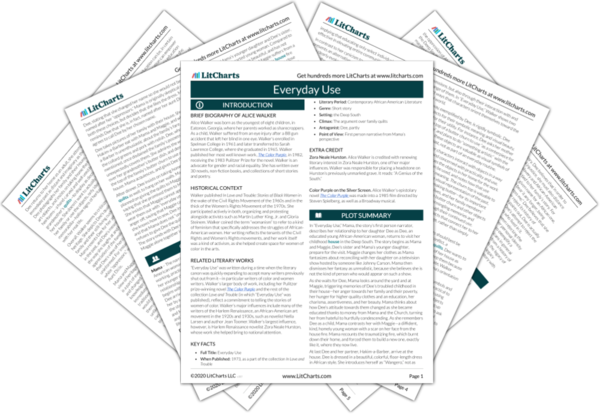Heritage and the Everyday
Heritage, and its relationship to daily life, is the central question that Walker explores in “Everyday Use.” Through the eyes of Mama, and through the contrasting characters of Dee and Maggie, Walker offers two varying views of what family history, the past, and “heritage” really mean.
In Dee’s view, heritage is a kind of dead past, distanced from the present through nostalgia and aestheticization (which means reducing something to a symbol or piece…
read analysis of Heritage and the EverydayEducation
Through Dee, “Everyday Use” explores how education affects the lives of people who come from uneducated communities, considering the benefits of an education as well as the tradeoffs.
Alice Walker clearly believes that education can be, in certain ways, helpful to individuals. For one, education can empower people financially and therefore materially. Dee’s education rewards her with the “nice things” she has desired since she was a child: gold earrings, a camera, sunglasses. The…
read analysis of EducationObjects, Symbolism, and Writing
As Mama narrates “Everyday Use,” she uses a multitude of objects and material goods to tell her story. Through Mama and her attention to objects, Walker investigates the meaning of materiality in fiction and explores the various ways they can be used for storytelling.
In the first place, material goods work in “Everyday Use” to stand in for and help describe characters’ identities. For example, Mama marks Dee’s difference from the rest of her…
read analysis of Objects, Symbolism, and Writing
Racism, Resistance, and Sacrifice
Race structures the social and economic conditions of characters’ daily lives in “Everyday Use.” From the first few paragraphs, Walker makes it clear that the oppression of African-Americans is built into the society of the Deep South, where Mama and Maggie live. This injustice manifests itself in a multitude of ways, ranging from Mama’s inability to look “a strange white man in the eye” to her mentions of racialized violence, like the time when “the…
read analysis of Racism, Resistance, and Sacrifice











